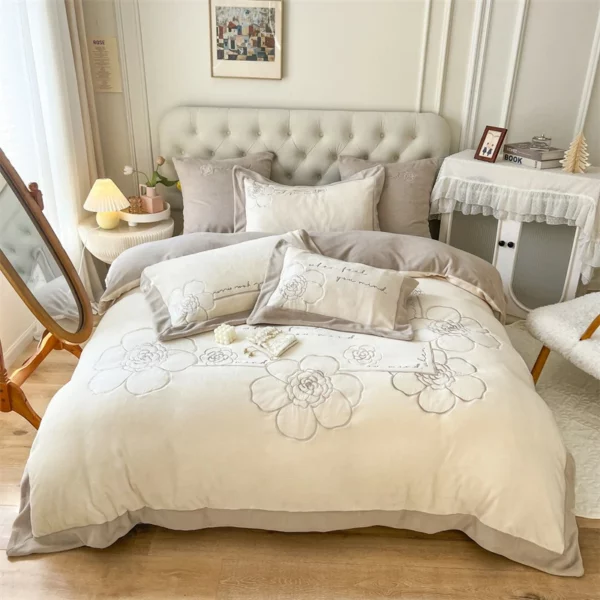The weight of the material used in waterproof twin size bedding sets can vary depending on the specific materials and construction methods employed by different manufacturers. Waterproof bedding sets often consist of multiple layers, each serving a specific purpose in providing water resistance and comfort.
Here are some general considerations regarding the weight of materials in waterproof twin size bedding sets:
- Top Layer (Facing Layer):
- The top layer of the bedding set, also known as the facing layer or cover, is typically made from a waterproof or water-resistant material. Common choices include materials with polyurethane coatings, laminated fabrics, or specialty waterproof membranes. The weight of this layer can vary based on the type of material used, with lighter materials being suitable for more breathable designs.
- Inner Layers:
- Beneath the facing layer, waterproof bedding sets may include inner layers that provide additional protection and comfort. These layers can include materials such as polyester or other synthetic fills, which add insulation and cushioning. The weight of these inner layers contributes to the overall weight of the bedding set.
- Breathable Membranes:
- Some waterproof bedding sets incorporate breathable membranes to balance waterproofing with breathability. These membranes, often made of materials like polyurethane or ePTFE (expanded polytetrafluoroethylene), add a minimal amount of weight while enhancing comfort.
- Base Fabric:
- The base fabric, which forms the foundation of the bedding set, is typically a durable and tear-resistant material. Common choices include polyester or cotton blends. The weight of this layer is influenced by the specific blend and thickness of the fabric.
- Seam Tapes and Reinforcements:
- To enhance waterproofing, seam tapes and reinforcements may be added to critical areas. These components contribute minimally to the overall weight but play a crucial role in preventing water ingress through seams.
- Overall Weight:
- The overall weight of a waterproof twin size bedding set can vary, but it is generally designed to be manageable for easy handling and laundering. Lightweight designs are often preferred for user convenience, especially in bedding intended for regular use.
- Fill Material (if applicable):
- If the bedding set includes a comforter or quilt with fill material, the type and amount of fill contribute to the weight. Common fill materials include polyester, down alternatives, or natural down, each with its own weight characteristics.
It’s important to note that manufacturers may provide specific details on the weight of their bedding sets or individual components. Additionally, advancements in textile technology allow for lightweight yet effective waterproofing solutions. Consumers looking for a waterproof twin size bedding set can refer to product specifications, user reviews, and manufacturer information to understand the weight and features of the chosen product.
What testing standards or certifications ensure the waterproof quality of twin size bedding set?
The waterproof quality of twin size bedding sets is often assessed through testing standards and certifications to ensure that the products meet specific performance criteria. twin size bedding set While there may not be a single universal standard for waterproof bedding sets, various industry-recognized tests and certifications can be referenced.
Here are some commonly used standards and certifications:
- ASTM International Standards:
- ASTM International (formerly known as the American Society for Testing and Materials) develops and publishes standards for a wide range of products, including textiles. ASTM D751 and ASTM D6701 are examples of standards that may be used for testing the waterproof properties of textiles and fabrics.
- ISO Standards:
- The International Organization for Standardization (ISO) provides standards for various industries, and ISO 811 and ISO 20645 are examples of standards related to the resistance of textiles to water penetration.
- AATCC Test Methods:
- The American Association of Textile Chemists and Colorists (AATCC) offers specific test methods for assessing water resistance in textiles. AATCC Test Method 127 is one such standard for testing water resistance.
- OEKO-TEX® Certification:
- The OEKO-TEX® Standard 100 certification ensures that textiles have been tested for harmful substances. While it doesn’t specifically focus on waterproofing, it addresses overall safety and quality, which indirectly contributes to the assessment of bedding set materials.
- REACH Compliance:
- REACH (Registration, Evaluation, Authorization, and Restriction of Chemicals) is a European Union regulation that addresses the production and use of chemical substances. Compliance with REACH regulations ensures that the materials used in bedding sets adhere to specific safety and environmental standards.
- Waterproofing Membrane Standards:
- If the bedding set includes a waterproofing membrane (e.g., polyurethane or ePTFE), manufacturers may follow specific standards related to the performance and effectiveness of these membranes. These could include in-house testing or adherence to industry-recognized specifications.
- Brand-Specific Testing:
- Some bedding manufacturers conduct their own internal testing or work with independent testing laboratories to ensure that their products meet specific waterproofing standards. This may include proprietary testing methods or adherence to strict quality control protocols.
When purchasing a waterproof twin size bedding set, consumers can inquire about the testing standards and certifications that the product adheres to. Look for products that explicitly mention waterproof features, and check for relevant certifications on product labels or official documentation. Additionally, user reviews and testimonials can provide insights into the real-world performance of the bedding set in terms of waterproofing.
